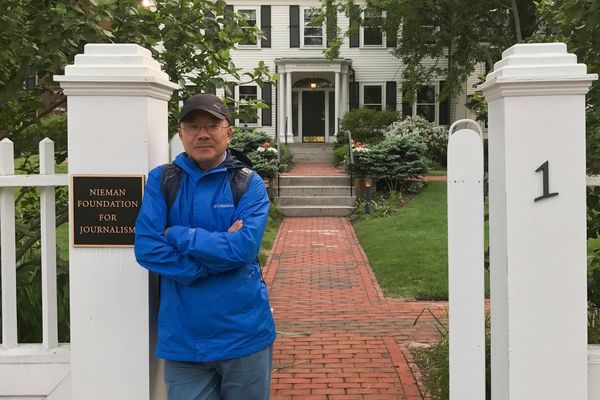
The flowers were bought first: five dozen roses in crimson, coral, gold, pale yellow and white. Then 36 long candles at a market filled with the smell of cilantro. Finally, the first of three pigs was slaughtered, its death-squeals echoing over the mountains.
In all, preparations for the feast took two days, a whole family called in to help, lugging sacks of corn to be boiled in huge steel vats on the street. The parts of the pig were washed in salt water and hung up to dry.

Above: Yolsitlalin Hernández, 11, and Joanna Hernández, 8, nieces of Benjamin Bautista, clean roses for the Saint Salvador celebration. Right: Smoke billows from a pot of pozole cooking over a wood fire.



Above left: Cristina Bautista stacks tamales in a large pot. Above right: Anayanzi Salvador, 2, tries to make tamales along with her aunts while everybody works on the celebration.
On Saturday evening, it all came together: the pork and corn had boiled for nearly 12 hours to make a rich pozole in giant pots. At 3am the townsfolk began arriving, taking home buckets of the steaming soup as the older men sat sipping mezcal and smoking.
The recent carnival, in honor of the Holy Saviour, is one of many such festivities that take place in Alpuyecancingo de las Montañas, a village deep in the mountains of Mexico’s Guerrero state, seven hours drive south-west of the capital. It is a town steeped in tradition, with a calendar marked by rituals honoring the Catholic saints, the harvest, the dead.
And, like many towns in Mexico, this one is tainted by tragedy. In a country where more than 100,000 people are missing, Alpuyecancingo has had one of its own snatched away: Benjamín Ascencio Bautista was one of the 43 students who vanished in September 2014.

Cristina Bautista sits for a portrait holding a nearly finished banner she made featuring the image of her son Benjamín Ascencio Bautista.
The night they disappeared, Benjamín and his classmates from a rural teachers’ college had commandeered a number of buses to use as transport for a protest commemorating the 1968 student massacre in Mexico City. Hijacking buses was a largely tolerated tradition, but that night, the students were attacked by police and other gunmen working for a violent cartel, who killed six people and took 43 students away into the night.
The case is the most egregious example of forced disappearance in Mexico. The practice, which was widely used by state security forces in the 1960s and ’70s, has become widespread among criminal groups. For many it is a fate worse than death: with no body, there can be no trace of the crime, and most cruelly, no closure for grieving families.

Joanna Hernández, right, and Yolsitlalin Hernández sweep their street beside an old poster that shows their uncle Benjamín and the other 42 students who disappeared eight years ago.
Like most disappearances, the vanishing of the 43 students remains unsolved, despite the promises of two successive presidents. The previous administration was accused of orchestrating an elaborate cover-up, while the current government’s case has also started to unravel. With still no trace of the majority of the students, no trials or convictions, the mass disappearance continues to fester.
But as in much of Mexico, a country ripped apart by criminal violence, the weight of this tragedy doesn’t get in the way of tradition: the parties, the celebrations, the feasts of pozole go on. Despite the horror elsewhere, here in Alpuyecancingo, there is still boundless joy.

Cruz Bautista, uncle of Benjamín and patron of Holy Saviour, lights a candle in the church for the celebration.
This year, the feast of Saint Salvador had special significance for Benjamín’s family: for the last 12 months, his uncle Cruz Bautista had been the saint’s patron, meaning he was charged with cleaning the statue in the town’s blue-painted church, replacing its flowers and candles.
As the feast of Holy Saviour approached, it was Cruz’s turn to hand over his duties in an elaborate ceremony that involved making enough food to feed dozens of people. It is an enormous expense for the family, particularly in a town that only started to prosper when residents began migrating north and to send money home in the late ’90s and early 2000s.
But as Benjamín’s grandfather, Juan Bautista, explained, such celebrations are what keep traditions alive.
“Our ancestors showed us the way,” he said. “We can’t stop it or change it. They showed us the path, and that’s where we’re going.”
Benjamín’s mother, Cristina Bautista, had traveled back to the town to help out with preparations for the feast. She is rarely home these days because she often travels across the country demanding authorities find her son. Once a month, she and more than a dozen parents of the 43 students march through the streets of Mexico City.




Clockwise from top left: Cristina Bautista serves pozole. Mayrani Bautista, sister of Benjamín, caresses her mother’s head after the Saint Salvador celebration. Cristina returns from bathing by the river carrying a healing plant she harvested. Cristina tells stories of her disappeared son Benjamín.
Her house remains a reminder of the seemingly unending injustice: on its brick outer wall hangs a giant poster with Benjamín’s face and those of his 42 missing companions. It has hung there so long under the punishing Guerrero sun, that the fabric has cracked and tattered, the faces fading to just outlines – only their dark eyebrows and hair remain.
“Until we find them!” the poster reads. “It’s been more than 36 months without an answer!”
That milestone came and went. Cristina and the other parents recently marked 100 months since their sons’ disappearance.
Despite her punishing travel schedule, Cristina has little chance to rest. She has rarely had a good night’s sleep since her son vanished. At home, she wakes every morning before dawn to brush her granddaughters’ hair and make them sopes before school – thick tortillas with raised edges with cheese, cream and purple onion sprinkled on top.
“Mexican pizzas,” Cristina calls them with a wide grin.
There are quiet moments, though, once the girls are off to school, when the sun streams gold into the house. Those are the times when Cristina and her daughter, Mayrani, talk about Benjamín, but it is rarely with sadness.

Cristina Hernández (6), niece of Benjamín, rests on her aunt’s bed.
Instead, they remember how he loved Harry Potter movies, how he adored Michael Jackson and taught himself to moonwalk. They laugh as they recall how he would wear his mother’s apron to do the dishes while listening to rock’n’roll, how he was always the best dancer at parties, his whole body shaking so much they called him “Boneless”.
Then Cristina is called back to help out with preparations: there are pigs to be slaughtered, corn to be boiled, tortillas and tamales to be made. It takes Benjamín’s whole sizable family, his aunts, uncles, cousins and nephews working together to get everything ready.
On Saturday afternoon, as the pozole boils, the family marches in a procession, carrying the bouquets of roses, the 36 candles draped in a garland of marigolds. A marching band, which the family has hired at considerable expense, follows as they walk twice around the little blue church.

Above: Cristina Bautista braids her granddaughter’s hair at breakfast before school. Right: Hominy, made from corn, is prepared for the pozole pot.



Above: Relatives of Benjamín prepare a pig for slaughter
Once inside, the family prays to the Holy Saviour, lighting the candles, replacing the flowers in crude plastic buckets, draping the marigolds around the holy effigy. Benjamín’s grandmother, who speaks only Indigenous nahuatl, walks around with a chalice of smoking copal incense.
Uncle Cruz grows increasingly exhausted as the weekend drags on, his clothes stained by pigs’ blood and sweat. But on Sunday morning, after a night spent doling out soup, he seems deliriously happy, smiling proudly as he watches the town council eat his family’s pozole.
Still, in Benjamín’s absence, the celebration is bittersweet.
“This time of year, everyone plays, we watch the nephews play together,” said Cruz. “As the immediate family, there really is still this emptiness.”
As the Bautista family finally sits down to eat some pozole themselves, Benjamín’s sister Mayrani pulls out her phone to show a picture of their old dog, Malfoy. She brings up her Instagram, and an old post comes up marking the eighth anniversary of her brother’s disappearance last year.
“And yes, I do still ask myself what our lives would be like if you were still with us,” she wrote above a photo of Benjamín looking proud at his high school graduation. “Hope is the last to die.”
By Sunday evening, Benjamín’s family, at last free of their burden, have given in to the celebration. There is the stink of spilled beer, the blare of loud music, his aunts delightedly dancing over the smooth concrete floor.
Leaning outside, Benjamín’s other uncle Esteban Bartolo looks on happily.
“Life is what’s important,” he says with a grin.
Afterwards, the whole group ambles up to the town square. Cruz has bought a giant tower made of fireworks, as is tradition. The wick is lit, the 10ft structure steadily erupting in a mass of sparkles, whistles, bangs and whizzing fire, the Bautista clan looking on in awe.

Fireworks light the sky during the celebration.
High above them, the final fireworks explode, a great shower of golden sparks raining down across the night sky.
Oscar Lopez is a fellow of the Alicia Patterson Foundation







